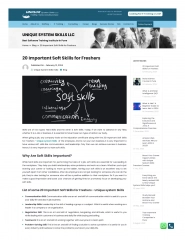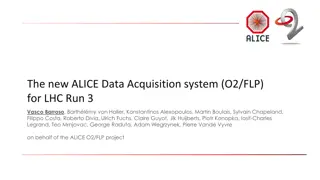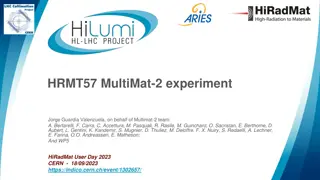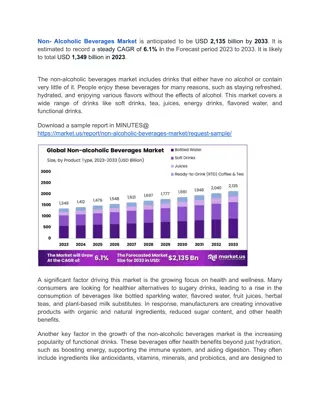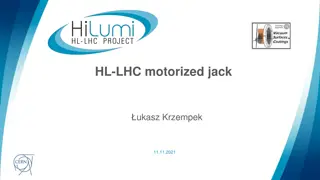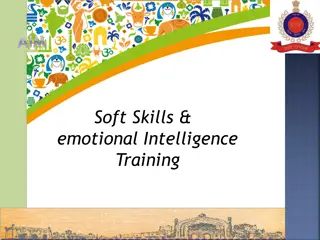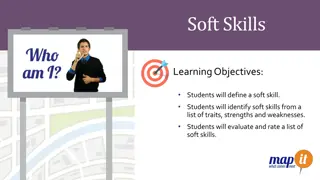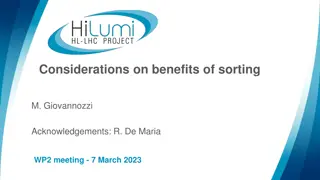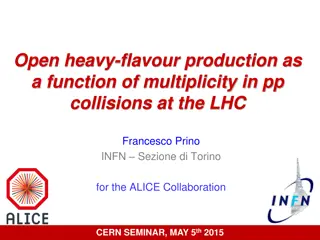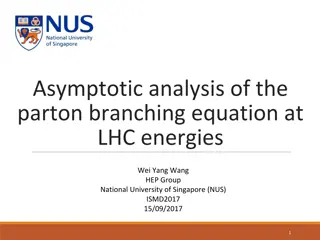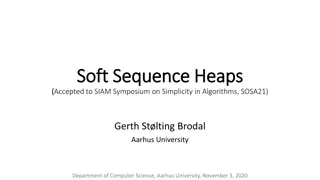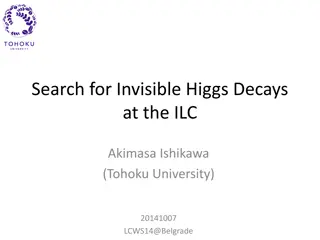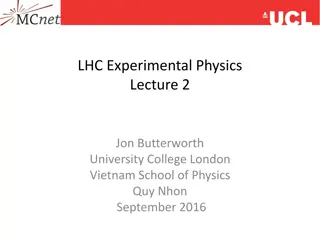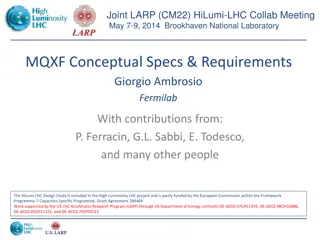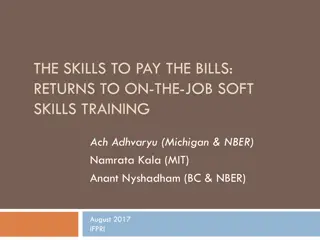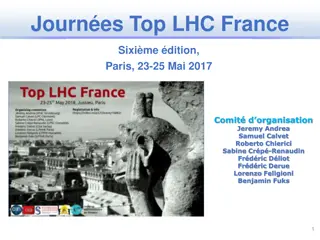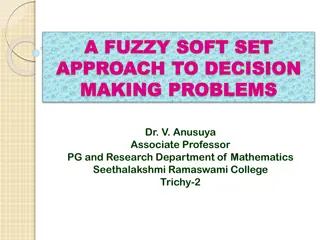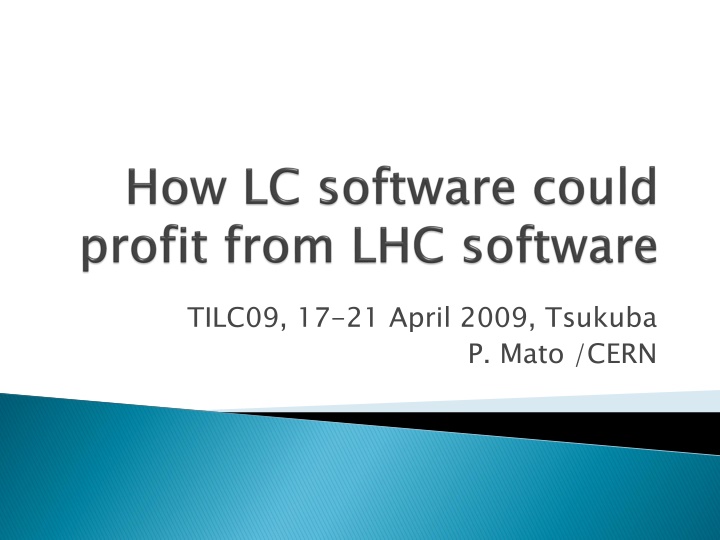
Review of Software Applications and Frameworks in High-Energy Physics
Discover the key role of software applications and frameworks in high-energy physics, including details on LHC software reuse for ILC, interoperability, and development levels. Explore the common components, specialized domains, and core libraries utilized in experiments, along with a focus on frameworks, algorithms, and building applications.
Download Presentation

Please find below an Image/Link to download the presentation.
The content on the website is provided AS IS for your information and personal use only. It may not be sold, licensed, or shared on other websites without obtaining consent from the author. If you encounter any issues during the download, it is possible that the publisher has removed the file from their server.
You are allowed to download the files provided on this website for personal or commercial use, subject to the condition that they are used lawfully. All files are the property of their respective owners.
The content on the website is provided AS IS for your information and personal use only. It may not be sold, licensed, or shared on other websites without obtaining consent from the author.
E N D
Presentation Transcript
TILC09, 17-21 April 2009, Tsukuba P. Mato /CERN
Former LHCb core software coordination Architect of the GAUDI framework Applications Area manager of the Worldwide LHC Computing Grid (WLCG) Develops and maintains that part of the physics applications software and associated infrastructure that is common among the LHC experiments Leader of the Software Development for Experiments (SFT) group in the Physics (PH) Department at CERN Projects: Geant4, ROOT, GENSER, SPI, CernVM, etc. TILC09, 17-21 April 2009, Tsukuba -- P. Mato/CERN 19/4/09 2
The main theme of this short presentation is a review what can be learn and reuse from the LHC software for the ILC Emphasis on interoperability, reuse and enabling independent developments Level 1- Application Interfaces/Formats Level 2 - Software Integrating Elements Review some of the interfaces and common packages developed in the context of LCG TILC09, 17-21 April 2009, Tsukuba -- P. Mato/CERN 19/4/09 3
Applications are built on top of frameworks and implementing the required algorithms (e.g. simulation, reconstruction, analysis, trigger) Applications Det Desc. Event Calib. Every experiment has a framework for basic services and various specialized frameworks: event model, detector description, visualization, persistency, interactivity, simulation, calibrarion Experiment Framework Data Mngmt. Distrib. Analysis Simulation Specialized domains that are common among the experiments (e.g. Geant4, COOL, Generators, etc.) Core Libraries Core libraries and services that are widely used and provide basic functionality (e.g. ROOT, CLHEP, HepMC, ) non-HEP specific software packages Many non-HEP libraries widely used (e.g. Xerces, GSL, Boost, etc.) TILC09, 17-21 April 2009, Tsukuba -- P. Mato/CERN 19/4/09 4
One or more implementations of each component exists for LHC Simulation Toolkits Event generators Detector simulation Statistical Analysis Tools Histograms, N-tuples Fitting Interactivity and User Interfaces GUI Scripting Interactive analysis Data Visualization and Graphics Event and Geometry displays Distributed Applications Parallel processing Grid computing Foundation Libraries Basic types Utility libraries System isolation libraries Mathematical Libraries Special functions Minimization, Random Numbers Data Organization Event Data Event Metadata (Event collections) Detector Description Detector Conditions Data Data Management Tools Object Persistency Data Distribution and Replication TILC09, 17-21 April 2009, Tsukuba -- P. Mato/CERN 19/4/09 5
C++ used almost exclusively by all LHC Experiments LHC experiments with an initial FORTRAN code base have completed the migration to C++ long time ago Large common software projects in C++ are in production for many years ROOT, Geant4, FORTRAN still in use mainly by the MC generators Large developments efforts are being put for the migration to C++ (Pythia8, Herwig++, Sherpa, ) Java is almost inexistent Exception is the ATLAS event display ATLANTIS TILC09, 17-21 April 2009, Tsukuba -- P. Mato/CERN 19/4/09 6
Scripting has been an essential component in the HEP analysis software for the last decades PAW macros (kumac) in the FORTRAN era C++ interpreter (CINT) in the C++ era Python is widely used by 3 out of 4 LHC experiments Most of the statistical data analysis and final presentation is done with scripts Interactive analysis Rapid prototyping to test new ideas Scripts are also used to configure complex C++ programs developed and used by the experiments Simulation and Reconstruction programs with hundreds or thousands of options to configure TILC09, 17-21 April 2009, Tsukuba -- P. Mato/CERN 19/4/09 7
Python language is really interesting for two main reasons: High level programming language Simple, elegant, easy to learn language Ideal for rapid prototyping Used for scientific programming (www.scipy.org) Framework to glue different functionalities Any two pieces of software can be glued at runtime if they offer a Python interface With PyROOT any C++ class can be easy used from Python TILC09, 17-21 April 2009, Tsukuba -- P. Mato/CERN 19/4/09 8
Experiments have developed Software Frameworks General architecture of any event processing applications (simulation, trigger, reconstruction, analysis, etc.) To achieve coherency and to facilitate software re-use Hide technical details to the end-user Physicists Help the Physicists to focus on their physics algorithms Applications are developed by customizing the Framework By the composition of elemental Algorithms to form complete applications Using third-party components wherever possible and configuring them ALICE: AliROOT; ATLAS+LHCb: Athena/Gaudi; CMS: CMSSW TILC09, 17-21 April 2009, Tsukuba -- P. Mato/CERN 19/4/09 9
GAUDI is a mature software framework for event data processing used by several HEP experiments ATLAS, LHCb, HARP, GLAST, Daya Bay, Minerva, BES III, The same framework is used for all applications All applications behave the same way (configuration, logging, control, etc.) Re-use of Services (e.g. Det. description) Re-use of Algorithms (e.g. Recons -> HTL) Equivalent to MARLIN TILC09, 17-21 April 2009, Tsukuba -- P. Mato/CERN 19/4/09 10
Agreement on standard formats for input and output data is essential for independent development of different detector concepts Detector description, configuration data, MC generator data, raw data, reconstructed data, statistical data, etc. This has been the direction for the ILC software so far (e.g. lcdd, lcio, stdhep, gear, ) Unfortunately LHC has been standardizing on other formats/interfaces (e.g. HepMC, GDML, ROOT files, etc.) TILC09, 17-21 April 2009, Tsukuba -- P. Mato/CERN 19/4/09 11
To facilitate the integration of independently developed components to build a coherent [single] program Dictionaries Dictionaries provide meta data information (reflection) to allow introspection and interaction of objects in a generic manner The LHC strategy has been a single reflection system (Reflex) Scripting languages Interpreted languages are ideal for rapid prototyping They allow integration of independently developed software modules (software bus) Standardized on CINT and Python scripting languages Component model and plug-in management Modeling the application as a set of components with well defined interfaces Loading the required functionality at runtime TILC09, 17-21 April 2009, Tsukuba -- P. Mato/CERN 19/4/09 12
Python (PyROOT) Object I/O Scripting (CINT, Python) Plug-in management etc. CINT ROOT meta C++ Reflex data ROOT Reflex rootcint XDict.so X.h genreflex dictionaries TILC09, 17-21 April 2009, Tsukuba -- P. Mato/CERN 19/4/09 13
Highly optimized (speed & size) platform independent I/O system developed for more than 10 years Able to write/read any C++ object (event model independent) Almost no restrictions (default constructor needed) Make use of dictionaries Self-describing files Support for automatic and complex schema evolution Usable without user libraries All the LHC experiments rely on ROOT I/O for the next many years TILC09, 17-21 April 2009, Tsukuba -- P. Mato/CERN 19/4/09 14
FILES - based on ROOT I/O Complex data structure: event data, analysis data Management of object relationships: file catalogues Interface to Grid file catalogs and Grid file access Relational Databases Oracle, MySQL, SQLite Suitable for conditions, calibration, alignment, detector description data Complex use cases difficult to be satisfied by a single solution Isolating applications from the database implementations with a standardized relational database interface (CORAL) facilitate the life of the developers no change in the application to run in different environments encode good practices once for all TILC09, 17-21 April 2009, Tsukuba -- P. Mato/CERN 19/4/09 15
text editor HL Desc. (xml) GDML (xml) ROOT TGeom geometry (root) MC generators Geant4 HepMC Pythia Pythia HepMC Flugg MCTruth (root) MCDB Fluka TILC09, 17-21 April 2009, Tsukuba -- P. Mato/CERN 19/4/09 16
Geometry Description Markup Language (XML) Low level (materials, shapes, volumes and placements) Quite verbose to edit directly Directly understood by Geant4 and ROOT Long term commitment Has been extended by lcdd with sensitive volumes, regions, visualization attributes, etc. TILC09, 17-21 April 2009, Tsukuba -- P. Mato/CERN 19/4/09 17
Event record written in C++ for HEP MC Generators. Many extensions from HEPEVT (the Fortran HEP standard common block) Agreed interface between MC authors and clients (LHC experiments, Geant4, ) I/O support Read and Write ASCII files. Handy but not very efficient. HepMC events can also be stored with ROOT I/O TILC09, 17-21 April 2009, Tsukuba -- P. Mato/CERN 19/4/09 18
Unfortunately very little has been done in common between the LHC experiments Different Event Models Different Data Processing Frameworks The equivalent of the LCIO event data model did not exists Within a given experiment, alternative set of algorithms has been developed and could be evaluated thanks to the common event model and framework TILC09, 17-21 April 2009, Tsukuba -- P. Mato/CERN 19/4/09 19
ROOT is the facto standard and repository for all these common functionality Histogramming, random numbers, liner algebra, numerical algorithms, fitting, multivariate analysis, statistical classes, etc. The aim is to continue to provide and support a coherent set of mathematical and statistical functions which are needed for the analysis, reconstruction and simulation TILC09, 17-21 April 2009, Tsukuba -- P. Mato/CERN 19/4/09 20
Re-using existing software packages saves on development effort but complicates software configuration Need to hide this complexity A configuration is a combination of packages and versions that are coherent and compatible E.g. LHC experiments build their application software based on a given LCG/AA configuration Interfaced to the experiments configuration systems (SCRAM, CMT) Pere Mato, CERN/PH 21
CernVM is a virtual appliance that is being developed to provide a portable and complete software environment for all LHC experiments Decouples experiment software from system software and hardware It comes with a read only file system optimized for software distribution Operational in offline mode for as long as you stay within the cache Reduces the effort to install, maintain and keep up to date the experiment software Distributed Data Analysis and Tools 26/9/09 22
LHC and ILC have been standardizing on different interfaces and packages In some cases ILC is relying on packages considered obsolete by the LHC community (e.g. CLHEP, AIDA, stdhep, ) Common interfaces/formats is good but adopting a common framework is even better It would enable one level up in re-use ILC could leverage from existing structures and support for the common LHC software TILC09, 17-21 April 2009, Tsukuba -- P. Mato/CERN 19/4/09 23

